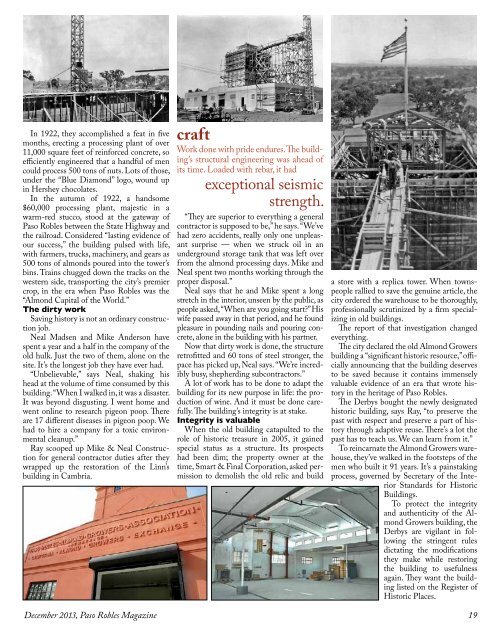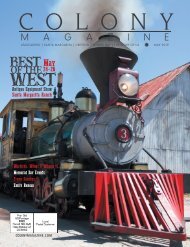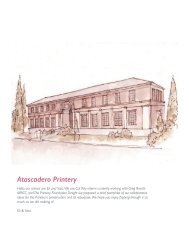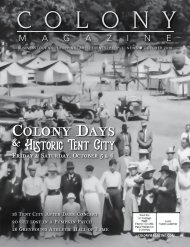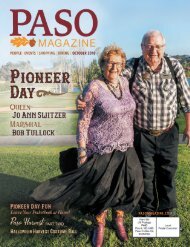2013 December PASO Magazine
A monthly look at life in the remarkable community of Paso Robles.
A monthly look at life in the remarkable community of Paso Robles.
Create successful ePaper yourself
Turn your PDF publications into a flip-book with our unique Google optimized e-Paper software.
In 1922, they accomplished a feat in five<br />
months, erecting a processing plant of over<br />
11,000 square feet of reinforced concrete, so<br />
efficiently engineered that a handful of men<br />
could process 500 tons of nuts. Lots of those,<br />
under the “Blue Diamond” logo, wound up<br />
in Hershey chocolates.<br />
In the autumn of 1922, a handsome<br />
$60,000 processing plant, majestic in a<br />
warm-red stucco, stood at the gateway of<br />
Paso Robles between the State Highway and<br />
the railroad. Considered “lasting evidence of<br />
our success,” the building pulsed with life,<br />
with farmers, trucks, machinery, and gears as<br />
500 tons of almonds poured into the tower’s<br />
bins. Trains chugged down the tracks on the<br />
western side, transporting the city’s premier<br />
crop, in the era when Paso Robles was the<br />
“Almond Capital of the World.”<br />
The dirty work<br />
Saving history is not an ordinary construction<br />
job.<br />
Neal Madsen and Mike Anderson have<br />
spent a year and a half in the company of the<br />
old hulk. Just the two of them, alone on the<br />
site. It’s the longest job they have ever had.<br />
“Unbelievable,” says Neal, shaking his<br />
head at the volume of time consumed by this<br />
building. “When I walked in, it was a disaster.<br />
It was beyond disgusting. I went home and<br />
went online to research pigeon poop. There<br />
are 17 different diseases in pigeon poop. We<br />
had to hire a company for a toxic environmental<br />
cleanup.”<br />
Ray scooped up Mike & Neal Construction<br />
for general contractor duties after they<br />
wrapped up the restoration of the Linn’s<br />
building in Cambria.<br />
craft<br />
Work done with pride endures. The building’s<br />
structural engineering was ahead of<br />
its time. Loaded with rebar, it had<br />
exceptional seismic<br />
strength.<br />
“They are superior to everything a general<br />
contractor is supposed to be,” he says. “We’ve<br />
had zero accidents, really only one unpleasant<br />
surprise — when we struck oil in an<br />
underground storage tank that was left over<br />
from the almond processing days. Mike and<br />
Neal spent two months working through the<br />
proper disposal.”<br />
Neal says that he and Mike spent a long<br />
stretch in the interior, unseen by the public, as<br />
people asked, “When are you going start?” His<br />
wife passed away in that period, and he found<br />
pleasure in pounding nails and pouring concrete,<br />
alone in the building with his partner.<br />
Now that dirty work is done, the structure<br />
retrofitted and 60 tons of steel stronger, the<br />
pace has picked up, Neal says. “We’re incredibly<br />
busy, shepherding subcontractors.”<br />
A lot of work has to be done to adapt the<br />
building for its new purpose in life: the production<br />
of wine. And it must be done carefully.<br />
The building’s integrity is at stake.<br />
Integrity is valuable<br />
When the old building catapulted to the<br />
role of historic treasure in 2005, it gained<br />
special status as a structure. Its prospects<br />
had been dim; the property owner at the<br />
time, Smart & Final Corporation, asked permission<br />
to demolish the old relic and build<br />
a store with a replica tower. When townspeople<br />
rallied to save the genuine article, the<br />
city ordered the warehouse to be thoroughly,<br />
professionally scrutinized by a firm specializing<br />
in old buildings.<br />
The report of that investigation changed<br />
everything.<br />
The city declared the old Almond Growers<br />
building a “significant historic resource,” officially<br />
announcing that the building deserves<br />
to be saved because it contains immensely<br />
valuable evidence of an era that wrote history<br />
in the heritage of Paso Robles.<br />
The Derbys bought the newly designated<br />
historic building, says Ray, “to preserve the<br />
past with respect and preserve a part of history<br />
through adaptive reuse. There’s a lot the<br />
past has to teach us. We can learn from it.”<br />
To reincarnate the Almond Growers warehouse,<br />
they’ve walked in the footsteps of the<br />
men who built it 91 years. It’s a painstaking<br />
process, governed by Secretary of the Interior<br />
Standards for Historic<br />
Buildings.<br />
To protect the integrity<br />
and authenticity of the Almond<br />
Growers building, the<br />
Derbys are vigilant in following<br />
the stringent rules<br />
dictating the modifications<br />
they make while restoring<br />
the building to usefulness<br />
again. They want the building<br />
listed on the Register of<br />
Historic Places.<br />
<strong>December</strong> <strong>2013</strong>, Paso Robles <strong>Magazine</strong> 19


